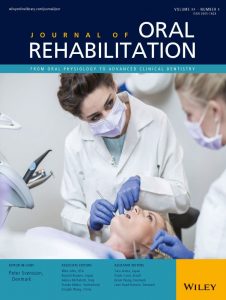Publications

Association between myotonometric measurement of masseter muscle stiffness and maximum bite force in healthy elders
Authors: Koji Hara 1, Chizuru Namiki 1, Kohei Yamaguchi 1, Kenichiro Kobayashi 2, Takayuki Saito 2, Kazuharu Nakagawa 1, Miki Ishii 1, Takuma Okumura 1, Haruka Tohara 1
Affiliations:
- Department of Gerodontology, Division of Gerontology and Gerodontology, Tokyo Medical and Dental University, Tokyo, Japan
- Kobayashi Dental Clinic, Tokyo, Japan
Journal: Journal of Oral Rehabilitation - June 202, Volume 47, Issue 6, Pages 750-756 (DOI: 10.1111/joor.12968)
-
Field & Applications:
- Medical
- Orofacial muscles
- Gerontology / Ageing
- Musculoskeletal disorder
- Temporomandibular disorder
The myotonometer used for measuring muscle stiffness was proven reliable and accurate for general skeletal muscles. Our study showed that MMS also had high inter- and intra-reliability. Muscle stiffness measurements obtained during maximum voluntary contraction was reported to provide an indirect, but valid, measure of muscle strength; muscle stiffness increases linearly with force of contraction. Furthermore, myotonometric and surface electromyography (sEMG) measurements during maximal voluntary contraction were highly correlated.
A potential benefit of myotonometric measurement in the clinical setting is its ability to quickly and easily assess an individual’s capacity to contract the masseter muscle during forceful biting. This is an improvement over manual muscle testing because masseter muscle palpation only provides qualitative assessment.
Background: Maximum bite force (MBF) is a common and useful index of masticatory function; it correlates with physical strength in elderly people. Palpation of stiffness in the masseter muscle during forceful biting has been considered to be associated with MBF. However, this assessment method relies on subjective judgments; no study has verified the relationship between MBF and quantitative measurements of masseter muscle stiffness (MMS).
Objective: We aimed to verify the association between masseter muscle myotonometric assessment results and MBF.
Methods: In total, 117 community-dwelling >65-year-old individuals from the Tokyo metropolitan area were assessed. MMS on the dominant side during forceful biting was measured with a Myoton PRO device. Masseter muscle thickness (MMT) during rest and forceful biting was measured with an ultrasonic diagnostic apparatus, and the difference in MMT (DMMT) between the rest and forceful biting conditions was determined. MBF data were obtained with a pressure-sensitive sheet and an associated device. To determine the independent variables affecting MBF and MMS, multivariate linear regression analyses with adjustments for age, sex, and number of teeth were performed.
Results: The multivariate analysis revealed that MBF correlated with the number of teeth (β=0.489, p<0.001) and MMS (β=0.259, p=0.003) (R2=0.433). MMS correlated with MBF (β=0.308, p=0.003) and DMMT (β=0.430, p<0.001) (R2=0.326).
Key words: bite force, masseter muscle, muscle stiffness, myotonometric assessment, occlusal force
MMS possibly reflects a force generated by the masseter muscle during forceful biting. Therefore, MMS is effective to assess tooth loss as well as an index of masseter muscle strength when evaluating MBF.


